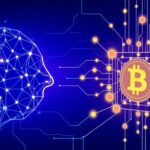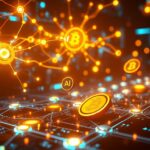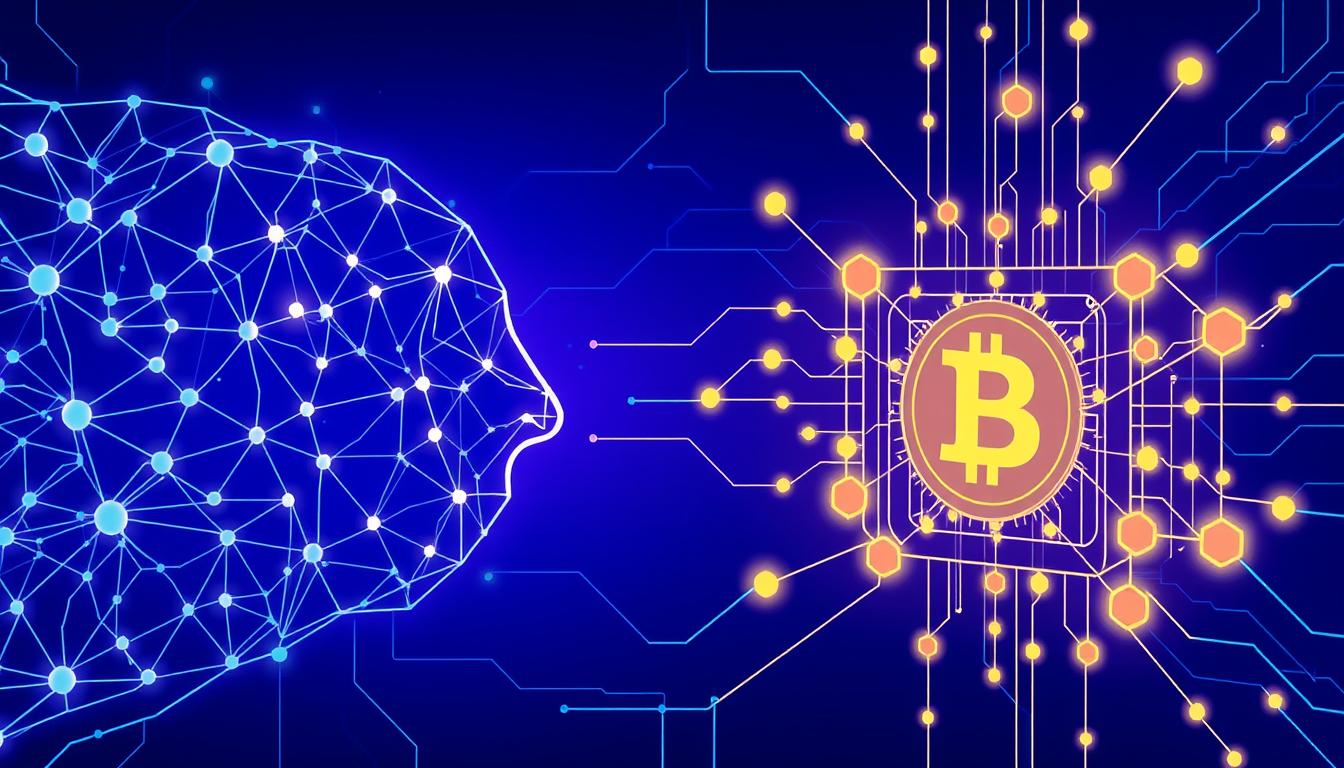The convergence of artificial intelligence and cryptocurrency represents one of the most exciting technological intersections of our time. With AI crypto startups raising over $2 billion in 2023 alone, this fusion is rapidly reshaping how we think about digital assets, automated trading, and decentralized intelligence. As these two revolutionary technologies continue to evolve together, understanding their relationship has become essential for anyone interested in the future of finance and technology.
How AI Enhances Blockchain Technology
AI systems analyzing blockchain data to enhance security and efficiency
Artificial intelligence is revolutionizing blockchain technology by addressing some of its most significant limitations. While blockchain provides immutable, transparent record-keeping, AI brings adaptive intelligence that can analyze vast amounts of data and identify patterns that would be impossible for humans to detect.
One of the most impactful applications is in security enhancement. AI algorithms can continuously monitor blockchain networks for suspicious activities, identifying potential vulnerabilities before they can be exploited. This proactive approach to security represents a significant advancement over traditional methods.
Additionally, AI helps solve the scalability challenges that have plagued many blockchain networks. Through intelligent routing and transaction batching, AI-enhanced systems can process transactions more efficiently, reducing congestion and lowering fees.
Key Areas Where AI Improves Blockchain
Enhanced Security Protocols
AI systems can detect unusual patterns that might indicate fraud or hacking attempts, providing an additional layer of security beyond cryptographic protections. Machine learning algorithms analyze transaction histories to establish normal behavior patterns and flag deviations that might represent security threats.
Optimized Consensus Mechanisms
Artificial intelligence can improve the efficiency of consensus mechanisms by predicting which nodes are most likely to produce valid blocks, reducing the computational resources required for network validation. This makes blockchain networks faster and more energy-efficient.
Stay Updated on AI-Crypto Innovations
Get weekly insights on how AI is transforming blockchain technology and cryptocurrency markets.
AI-Powered Crypto Trading Strategies
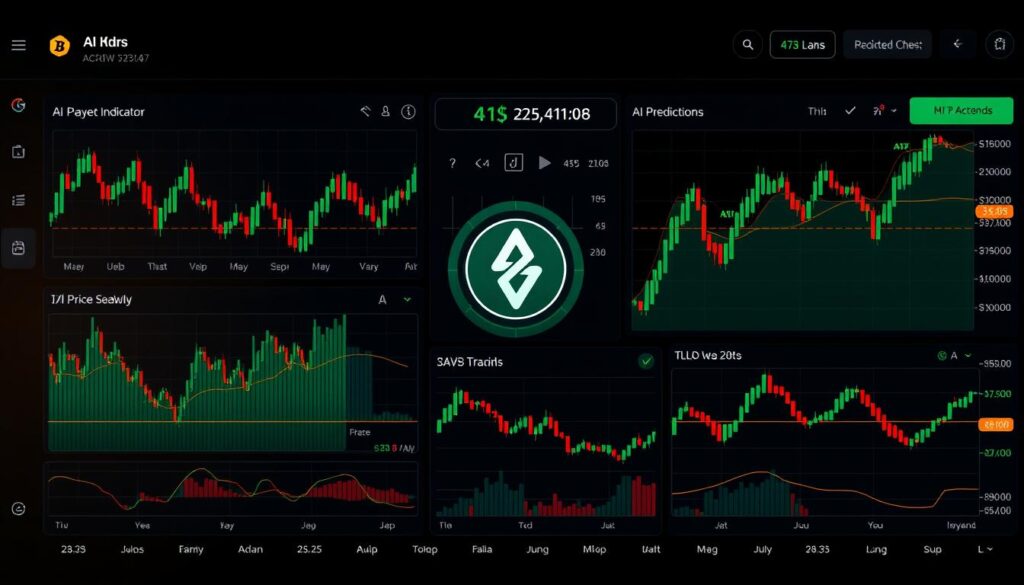
AI trading systems can analyze market data and execute trades with minimal human intervention
The volatile nature of cryptocurrency markets makes them particularly well-suited for AI-powered trading strategies. Unlike traditional markets, crypto exchanges operate 24/7, generating enormous amounts of data that can be analyzed by machine learning algorithms to identify profitable trading opportunities.
How AI Transforms Crypto Trading
Benefits of AI Trading
- Processes vast amounts of market data in real-time
- Eliminates emotional decision-making
- Executes trades at optimal times with microsecond precision
- Identifies patterns invisible to human traders
- Operates continuously without fatigue
Limitations to Consider
- Requires high-quality historical data for training
- May struggle with unprecedented market events
- Initial setup costs can be significant
- Algorithms require regular maintenance and updates
- Over-reliance can lead to unexpected losses
Advanced AI trading systems now incorporate sentiment analysis by scanning social media, news articles, and forum discussions to gauge market sentiment. This additional layer of intelligence helps predict price movements based on public perception and breaking news that might impact cryptocurrency values.
Top AI-Driven Crypto Projects to Watch
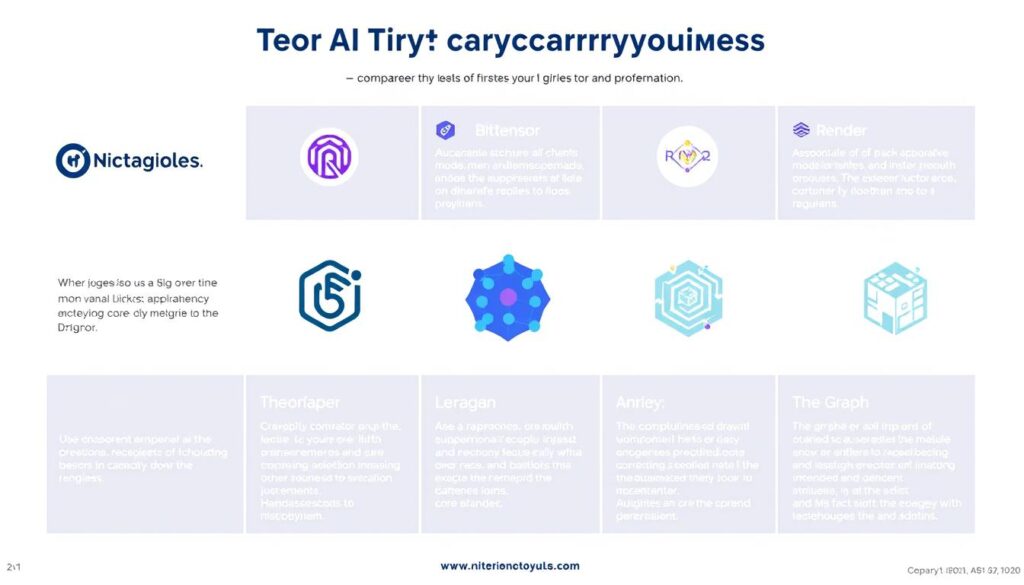
Leading AI cryptocurrency projects and their core technologies
Several innovative projects are leading the integration of AI and crypto technologies. These platforms are creating new possibilities for decentralized intelligence, automated markets, and AI-powered financial services.
Bittensor (TAO)
Bittensor has created a decentralized marketplace for AI models and computational resources. The network incentivizes the development of machine learning models through its native token, TAO. By allowing developers to monetize their AI algorithms directly, Bittensor is building a decentralized intelligence network that anyone can contribute to and benefit from.
Render (RNDR)
Render Network connects artists needing rendering power with GPU owners willing to share their computing resources. Built on Ethereum, this platform enables distributed GPU rendering for complex 3D projects, visual effects, and AI applications. The RNDR token facilitates transactions between creators and node operators.
Fetch.ai (FET)
Fetch.ai is building an open-access, tokenized, decentralized machine learning network to enable smart infrastructure. Its technology enables the deployment of AI agents that can perform complex tasks like optimizing travel routes, managing energy usage, or facilitating peer-to-peer transactions without intermediaries.
The Graph (GRT)
The Graph has developed an indexing protocol for querying blockchain data, making it easier to extract and analyze information from decentralized networks. Using AI-enhanced indexing, The Graph enables developers to build more sophisticated applications that can efficiently access and process on-chain data.
SingularityNET (AGIX)
SingularityNET aims to create a decentralized marketplace for AI services, allowing anyone to create, share, and monetize AI tools. The platform facilitates the emergence of artificial general intelligence (AGI) through collaborative development and a tokenized ecosystem that rewards innovation.
Ocean Protocol (OCEAN)
Ocean Protocol enables secure sharing and monetization of data while preserving privacy. This is crucial for AI development, which requires vast amounts of training data. By tokenizing data assets, Ocean creates new markets for information that can fuel machine learning advancement.
Get In-Depth Analysis on AI Crypto Projects
Receive our comprehensive guide to the most promising AI cryptocurrency projects with technical evaluations and growth potential assessments.
Practical Applications of AI in Crypto
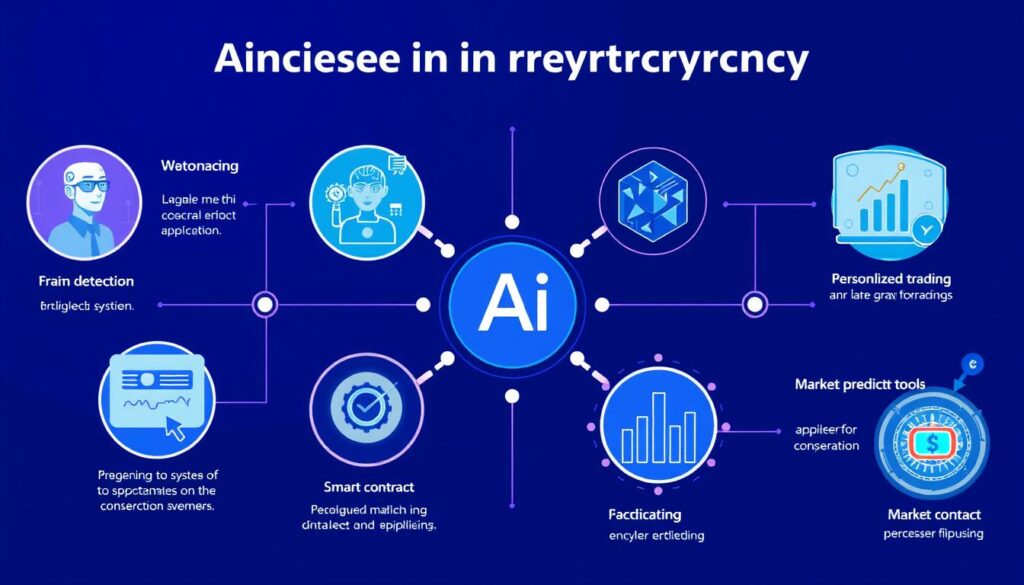
Real-world applications where AI is enhancing cryptocurrency functionality
Fraud Detection and Security
Artificial intelligence excels at identifying unusual patterns that might indicate fraudulent activity. In the cryptocurrency space, AI systems continuously monitor transactions, flagging those that deviate from established patterns. This capability is particularly valuable given the pseudonymous nature of blockchain transactions and the irreversibility of crypto transfers.
Advanced AI models can detect sophisticated scams by analyzing wallet behavior, transaction timing, and network connections. Some platforms now employ machine learning to identify potential Ponzi schemes or exit scams before users lose their funds.
Personalized Trading Assistance
AI-powered trading assistants are becoming increasingly sophisticated, offering personalized recommendations based on individual risk tolerance, investment goals, and market conditions. These systems learn from user behavior and adapt their strategies accordingly, providing a customized approach to cryptocurrency trading.
Unlike generic trading bots, these AI assistants can incorporate external factors like news events, social media sentiment, and macroeconomic indicators to provide more nuanced guidance. This holistic approach helps investors make more informed decisions in a highly volatile market.
Smart Contract Optimization
Smart contracts are self-executing agreements with terms written in code, but they can contain vulnerabilities or inefficiencies. AI tools now help developers identify potential issues before deployment, reducing the risk of exploits or unnecessary gas fees.
Machine learning algorithms can analyze thousands of existing smart contracts to identify best practices and common pitfalls, suggesting improvements that enhance security and reduce execution costs. This application of AI is particularly valuable as decentralized finance (DeFi) continues to grow in complexity and value.
Challenges and Risks in AI-Crypto Integration
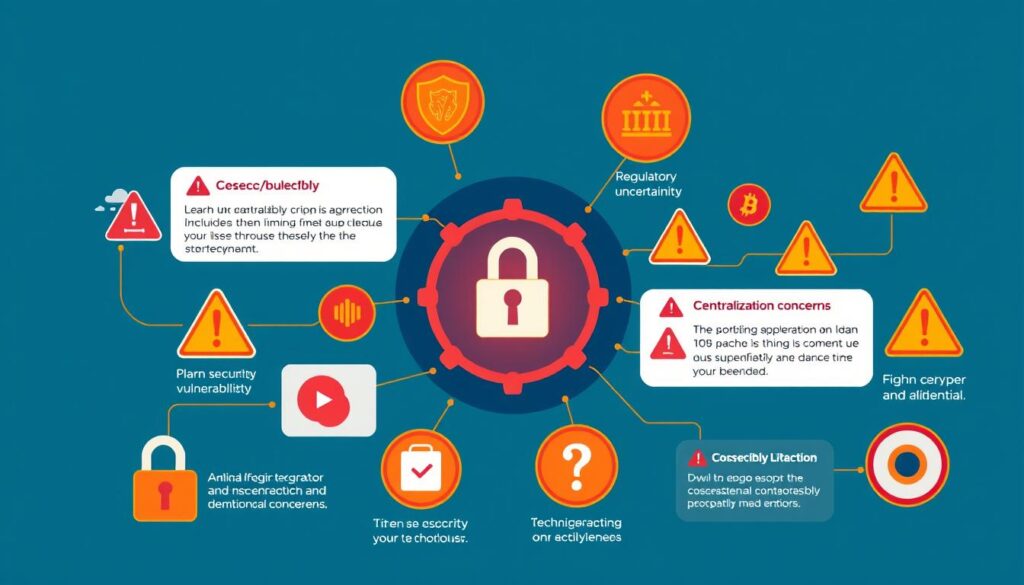
Key challenges facing the integration of AI and cryptocurrency technologies
Despite the promising potential of combining AI and cryptocurrency, several significant challenges and risks must be addressed for this integration to reach its full potential.
What are the security implications of AI in cryptocurrency?
While AI can enhance security, it also introduces new vulnerabilities. AI systems themselves can become targets for attacks, potentially compromising the cryptocurrency platforms they protect. Additionally, adversarial machine learning techniques could be used to manipulate AI trading systems or security protocols.
There’s also the risk of over-reliance on AI security measures, which might create a false sense of security. No system is infallible, and AI-based security should be one component of a comprehensive security strategy rather than the sole protection mechanism.
How does regulatory uncertainty affect AI-crypto development?
Both AI and cryptocurrency face evolving regulatory landscapes, creating a doubly uncertain environment for projects combining these technologies. Regulations designed for traditional financial systems may not adequately address the unique characteristics of AI-driven crypto platforms.
Developers must navigate complex compliance requirements across multiple jurisdictions, often without clear guidance. This regulatory uncertainty can slow innovation and increase operational costs as projects attempt to future-proof their systems against potential regulatory changes.
What technical limitations exist in current AI-crypto systems?
Current AI-crypto integrations face several technical challenges. AI systems require significant computational resources, which can be at odds with the distributed nature of blockchain networks. This tension between centralized AI processing and decentralized blockchain validation remains difficult to resolve efficiently.
Additionally, AI models need vast amounts of high-quality data for training, but cryptocurrency markets are relatively new with limited historical data. This can affect the accuracy and reliability of AI predictions, especially during unprecedented market conditions.
Important consideration: The integration of AI and cryptocurrency raises important questions about centralization. If a few entities control the most powerful AI systems analyzing and interacting with blockchain networks, this could undermine the decentralized ethos that is fundamental to cryptocurrency.
Future Predictions: AI and Crypto from 2025-2030
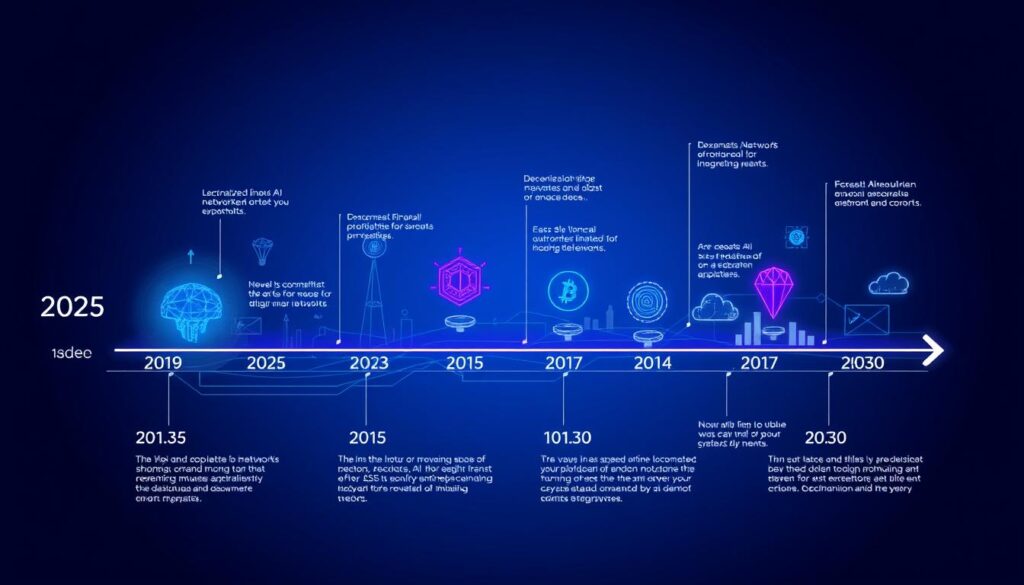
Projected evolution of AI and crypto technologies over the next five years
Looking ahead to the next five years, we can anticipate several significant developments in the AI-crypto space. These predictions are based on current technological trajectories and emerging research directions.
Decentralized AI Networks
By 2026, we expect to see fully functional decentralized AI networks where machine learning models can be trained, deployed, and monetized without centralized control. These networks will enable a new generation of applications that combine the trustlessness of blockchain with the adaptive intelligence of AI.
These systems will likely operate through tokenized incentive structures that reward both computational resource providers and algorithm developers. This democratization of AI could accelerate innovation by allowing specialists from around the world to collaborate and build upon each other’s work.
Autonomous Financial Entities
By 2028, we may see the emergence of fully autonomous financial entities—AI systems that operate independently on blockchain networks, managing assets and making investment decisions without human intervention. These systems could function as decentralized autonomous organizations (DAOs) with sophisticated decision-making capabilities.
Such entities might manage investment portfolios, provide insurance services, or facilitate complex financial arrangements between parties. Their operation would be transparent and verifiable on the blockchain, while their decision-making would be powered by advanced AI algorithms.
Regulatory Adaptation
The regulatory landscape will likely evolve significantly by 2030, with new frameworks specifically designed to address the unique challenges of AI-crypto integration. These regulations may focus on algorithmic accountability, requiring transparency in how AI systems make decisions that affect cryptocurrency markets.
We may also see the development of regulatory AI tools that can monitor compliance in real-time, creating a more responsive and nuanced regulatory environment that can keep pace with technological innovation.
Be Prepared for the Future of AI and Crypto
Join our community of forward-thinking enthusiasts and receive exclusive insights on emerging trends at the intersection of AI and cryptocurrency.
Getting Started with AI and Crypto
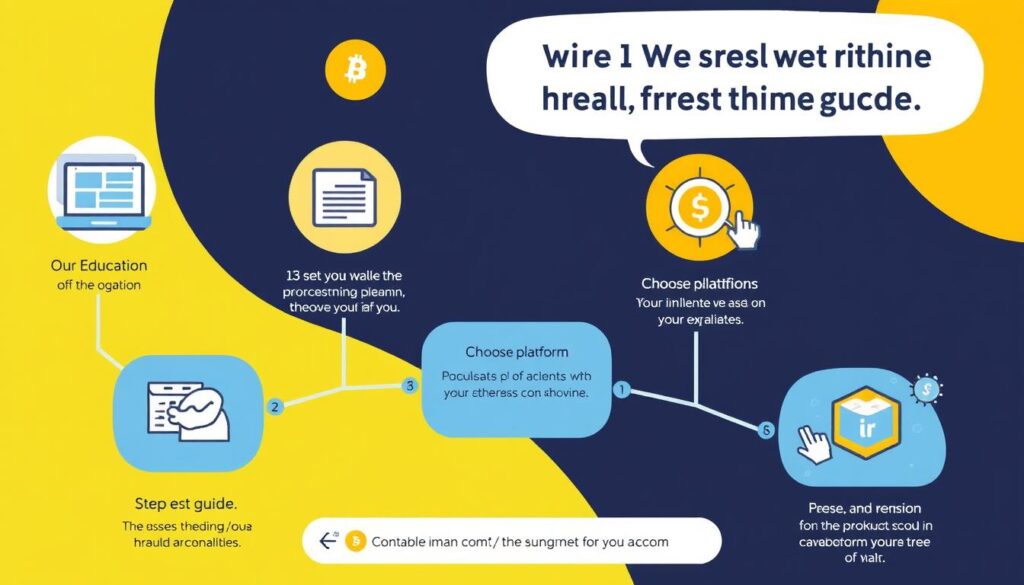
Beginner’s roadmap to exploring AI and cryptocurrency technologies
For those interested in exploring the intersection of AI and cryptocurrency, here are some practical steps to begin your journey:
- Take online courses in both AI fundamentals and blockchain technology
- Follow reputable AI-crypto projects on social media for updates
- Join community forums where enthusiasts discuss developments
- Read whitepapers of leading projects to understand their technology
- Attend virtual conferences and webinars focused on these technologies
Education First
- Set up a small cryptocurrency portfolio to understand the market
- Experiment with open-source AI tools for market analysis
- Try using AI-powered trading platforms with demo accounts
- Contribute to community-driven AI-crypto projects
- Build simple applications that utilize both technologies
Practical Experience
- Start with small investments you can afford to lose
- Diversify across different AI-crypto projects
- Verify the credibility of projects before investing
- Be skeptical of projects promising unrealistic returns
- Keep updated on security best practices for digital assets
Risk Management
“The most exciting aspect of combining AI and cryptocurrency is not what we can build today, but what these technologies will enable us to imagine tomorrow. We’re just beginning to explore the possibilities of truly intelligent, trustless systems.”
Conclusion: Is AI the Missing Puzzle Piece for Crypto Mass Adoption?
The integration of artificial intelligence and cryptocurrency represents a powerful technological convergence with the potential to address many of the challenges that have limited crypto adoption. AI can enhance security, improve user experience, optimize efficiency, and create entirely new capabilities that weren’t previously possible.
However, this integration also brings new challenges related to centralization, regulation, and technical implementation. The coming years will be crucial in determining whether AI truly becomes the catalyst that propels cryptocurrency into mainstream use or whether unforeseen obstacles emerge.
What remains clear is that the intersection of AI and crypto will continue to be a hotbed of innovation, attracting brilliant minds and substantial investment. For those willing to learn and adapt, this convergence offers exciting opportunities to participate in shaping the future of finance and technology.
Is AI the missing puzzle piece for crypto mass adoption? The answer may not be straightforward, but the question itself highlights how these technologies are increasingly viewed as complementary rather than separate domains. As we move forward, their paths will likely become even more intertwined, creating a technological synergy greater than the sum of its parts.
What AI-Crypto Trend Surprises You Most?
Join our newsletter community to share your thoughts and stay updated on the latest developments at the intersection of AI and cryptocurrency.






